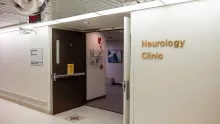Neurointerventional Surgery
- For all other requests:
- 1-800-777-8442
Cerebrovascular conditions are those that involve a blockage or malformation in the blood vessels in your brain or spine.
Invasive, or open, brain surgery used to be the only way to treat many of these conditions—and many weren’t treatable at all.
Today, University of Iowa Health Care experts in neurointerventional surgery can treat many conditions, including stroke, with minimally invasive procedures.
Performed using tiny incisions, specialized imaging, and precision instruments, these procedures offer less pain, fewer complications, and a faster recovery. Endovascular neurosurgery, neuroendovascular surgery, and cerebrovascular surgery are other names for this kind of surgery.
The UI Health Care neurointerventional surgery team uses the newest technology for diagnosis and treatment. They also develop and test new methods for improving diagnosis and treatment of cerebrovascular conditions.
Having neurointerventional surgery at UI Health Care
Neurointerventional surgery is a team effort, with neurologists, neurosurgeons, neuroradiologists, anesthesiologists, and other specialists all working together on your care. They meet as a group to discuss your case and make a treatment plan customized for you.
Diagnosis and treatment in a single procedure
Our leading-edge technology means that our physicians may be able to diagnose and treat your condition during the same procedure.
Even if you need traditional brain surgery, you may be able to have it immediately in the operating room that is connected to our angiography suite.
Types of neurointerventional surgery
Neurointerventional surgery is performed using specialized instruments. Your surgeon inserts them through small incisions in your groin or wrist and threads them through your blood vessels to reach the area to be treated.
The type of procedure you’ll have depends on your condition. It may be performed while you’re asleep under anesthesia or while you’re awake but relaxed with sedation.
Most people feel better right away after their procedure. If you’re having a non-emergency procedure, you may be able to go home the same day or the next day.
Procedures to treat stroke
- Thrombolytic therapy delivers “clot-busting” medication to dissolve blood clots that can cause ischemic strokes.
- Mechanical thrombectomy grabs and removes a blood clot from the brain. The UI Health Care team pioneered the use of this procedure to treat strokes up to 24 hours after they occur.
- Angioplasty and stenting of arteries in the head, neck, and spine opens blocked blood vessels so the blood can flow properly.
- Vasodilator infusion delivers medication to relax a blood vessel that’s spasming.
Procedures to treat brain aneurysms, fistulas, and arteriovenous malformations
- Embolization uses a special glue to close off blood vessels. It can treat brain aneurysms, tumors, arteriovenous malformations (AVM), and arteriovenous fistulas (AVF).
- Endovascular coiling places a coil of thin metal wire inside a brain aneurysm to keep the aneurysm from bursting.
Procedures to treat spine conditions
- Percutaneous vertebroplasty injects bone cement into a fractured vertebra in the spine to stabilize the fracture.
- Percutaneous kyphoplasty places a small balloon inside a fractured vertebra to push the fragments back into the correct shape. Bone cement is then injected to keep the vertebra intact.
- Minimally invasive lumbar decompression removes tissue that’s causing spinal stenosis.
What to expect
In our leading-edge biplane angiography suite, two digital X-ray cameras will take simultaneous images of your head, neck, and spine. You’ll be awake but relaxed with sedation.
After contrast dye is injected into your bloodstream, the cameras rotate around your body to create a 3D picture of your blood vessels and soft tissues.
Your team is able to see your blockage or malformation immediately on a computer screen. They’ll determine whether they can treat you with a minimally invasive procedure, or whether you’ll require traditional brain surgery.
Depending on what they find, you may be able to be treated immediately. In some cases, your team will work with you to schedule a later procedure.
Who can benefit from neurointerventional surgery?
Neurointerventional surgery may be an option if you have one of the following conditions:
- Arteriovenous malformations (AVMs)
- Brain aneurysms
- Brain tumors
- Carotid artery stenosis (narrowing of the arteries)
- Cavernomas (also called cavernous angiomas or cavernous malformations)
- Head and neck tumors
- Ischemic stroke
- Severe nosebleeds (epistaxis)
- Skull base and pituitary tumors
- Subarachnoid hemorrhage
- Venous and lymphatic malformations of the head and neck
Our Care Team







Looking for a specialist in minimally invasive brain surgery?
Locations and Offices

